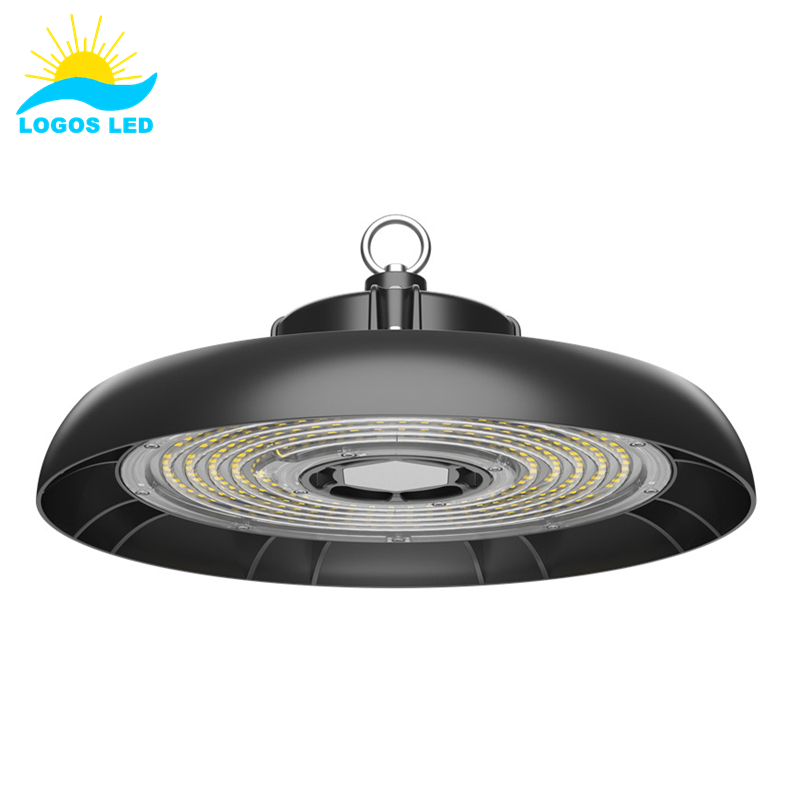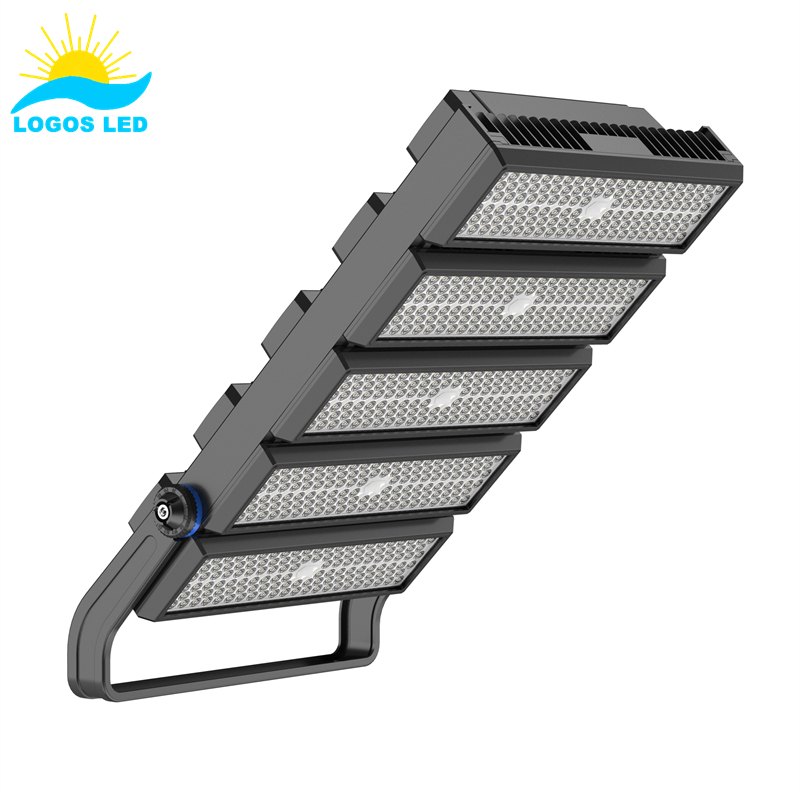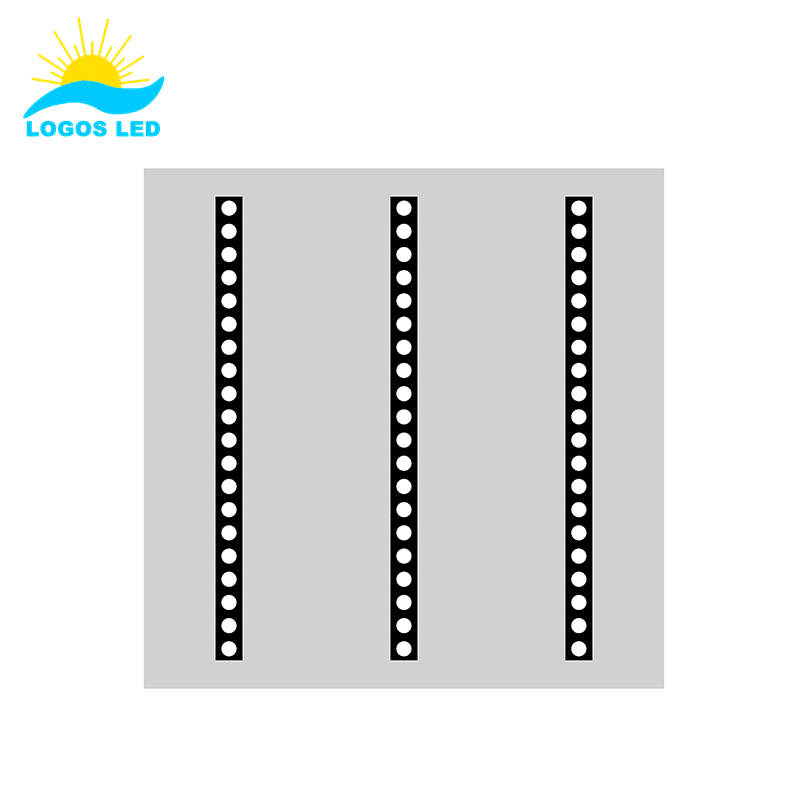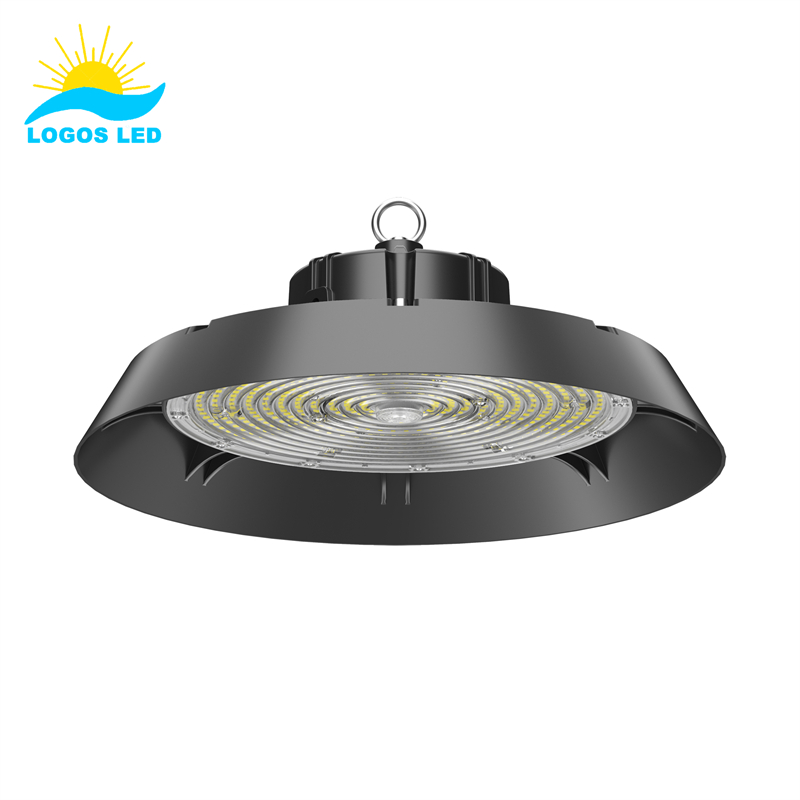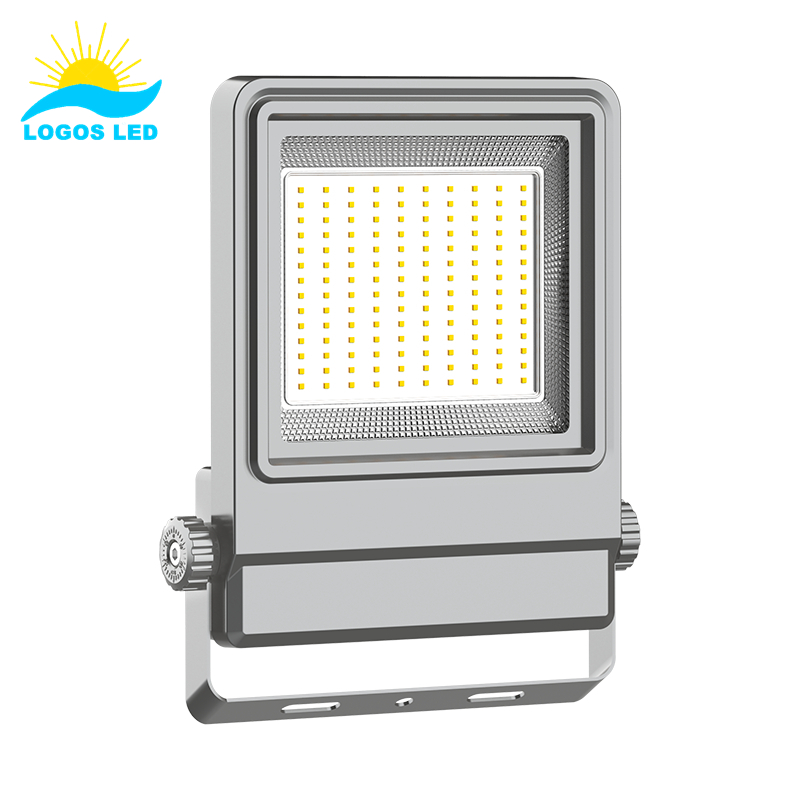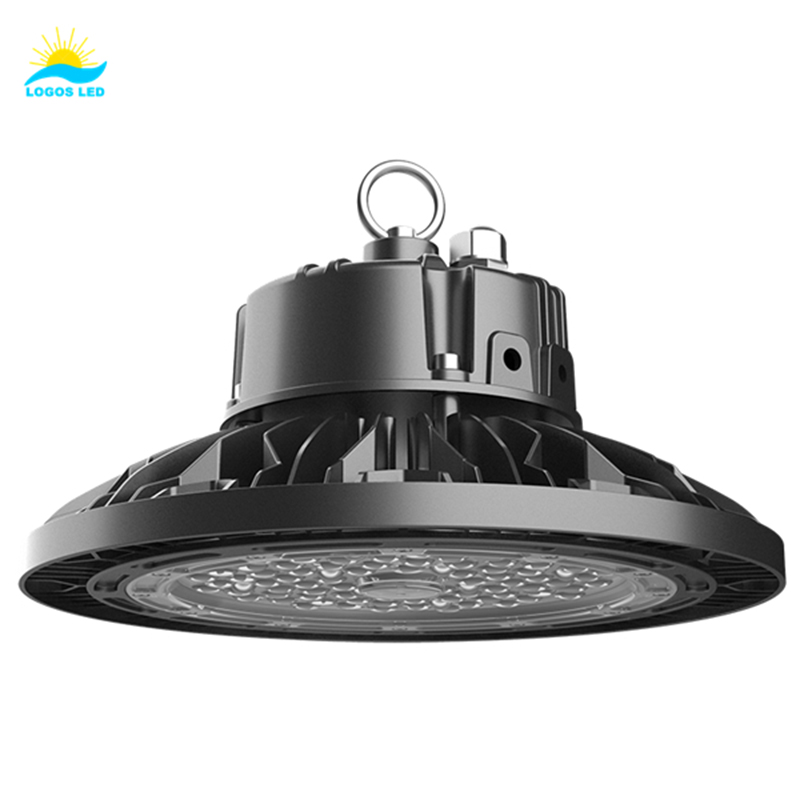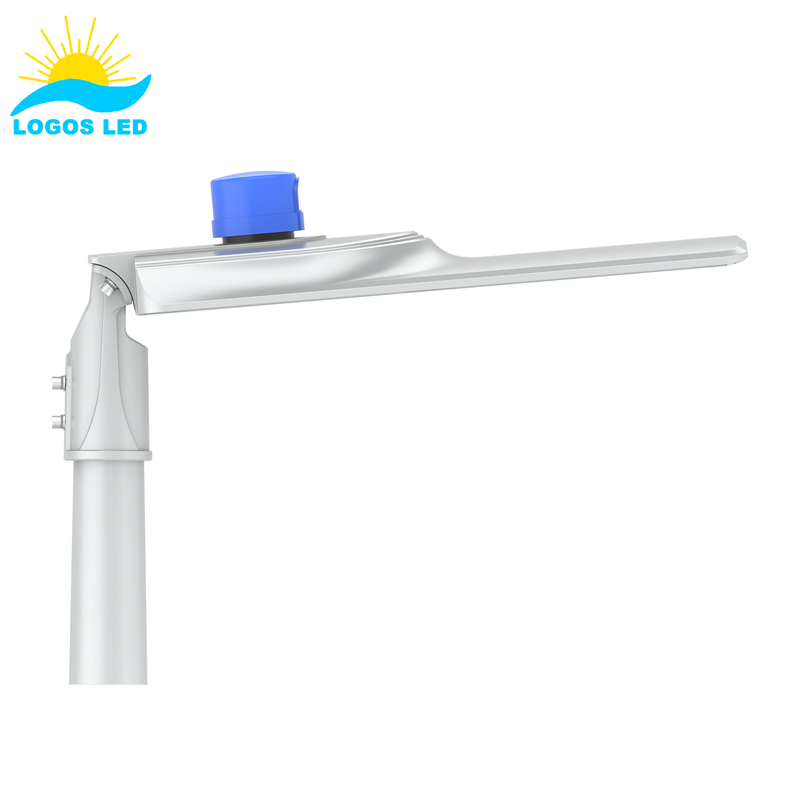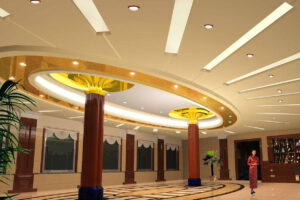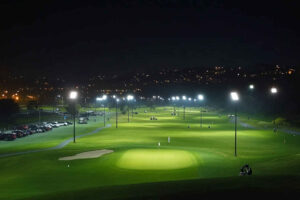Pain points in your golf course lighting can kill your play and drive up your maintenance costs, but if you get the right solutions in place, you can manage all of these. This guide will show you how to get the most out of your lighting to give your golfers a great experience.
You need specific lighting to make sure people can see and play golf on your course. You want to give your golfers the best experience possible, meet safety standards, and be efficient with your energy use. In this article, we’ll walk through what you need to think about with your golf course lighting.
Keep reading to find out the most important things to know about your golf course lighting.
Table of Contents
What are the specific lighting requirements for different areas of a golf course?
Your golf course has different lighting needs for different areas to make it safe, playable, and pretty at night when you hold events. Each area has different lighting needs based on what you’re doing and its size. Here’s a rundown of what you need:
1. Fairways and Tee Boxes
Fairways and tee boxes need even lighting with no shadows so people can see the ball and hit it where they want to hit it.
- Lighting requirements: Medium light levels (50–100 lux) with even coverage.
- Preferred fixtures: LED floodlights or high mast lights with wide beam angles to cover large areas evenly.
2. Greens and Holes
Greens need special lighting to make the undulations and slopes in the terrain stand out so people can see them and putt the ball where they want it to go.
- Lighting requirements: Higher illumination (200–300 lux) with minimal glare.
- Preferred fixtures: LED floodlights with focused beams to illuminate greens without disturbing adjacent areas.
3. Driving Ranges
Your driving range needs lights that go a long way so people can see where their golf balls are going. At the same time, you need lights that illuminate the hitting area and the range markers.
- Lighting requirements: High illumination (300–500 lux) with concentrated beams for distant visibility.
- Preferred fixtures: LED high mast lights or LED sports lights with narrow beam angles for targeted coverage.
4. Parking Lots and Pathways
Your parking lot and pathways need soft lighting so people can see but not be blinded by the lights.
- Lighting requirements: Low to medium illumination (20–50 lux) with energy-efficient fixtures.
- Preferred fixtures: LED streetlights or bulkhead lights with motion sensors for efficiency.
5. Clubhouses and Outdoor Seating Areas
You also need lights to make your place look nice and for people to see each other when they’re doing social stuff.
- Lighting requirements: Warm white light with moderate brightness.
- Preferred fixtures: LED panel lights, downlights, or decorative fixtures with dimming options for versatility.
6. Maintenance Areas
You need lights in your maintenance areas where your people work early in the morning or late at night. You need bright lights so they can see what they’re doing and be safe.
- Lighting requirements: Bright white light (100–200 lux).
- Preferred fixtures: LED vapor-proof lights or floodlights for durability and reliability.
Good lighting makes golf fun and lets people play at night. The best lights for you to use are high-quality LEDs. They last a long time, use very little electricity, and can be customized to fit your needs.
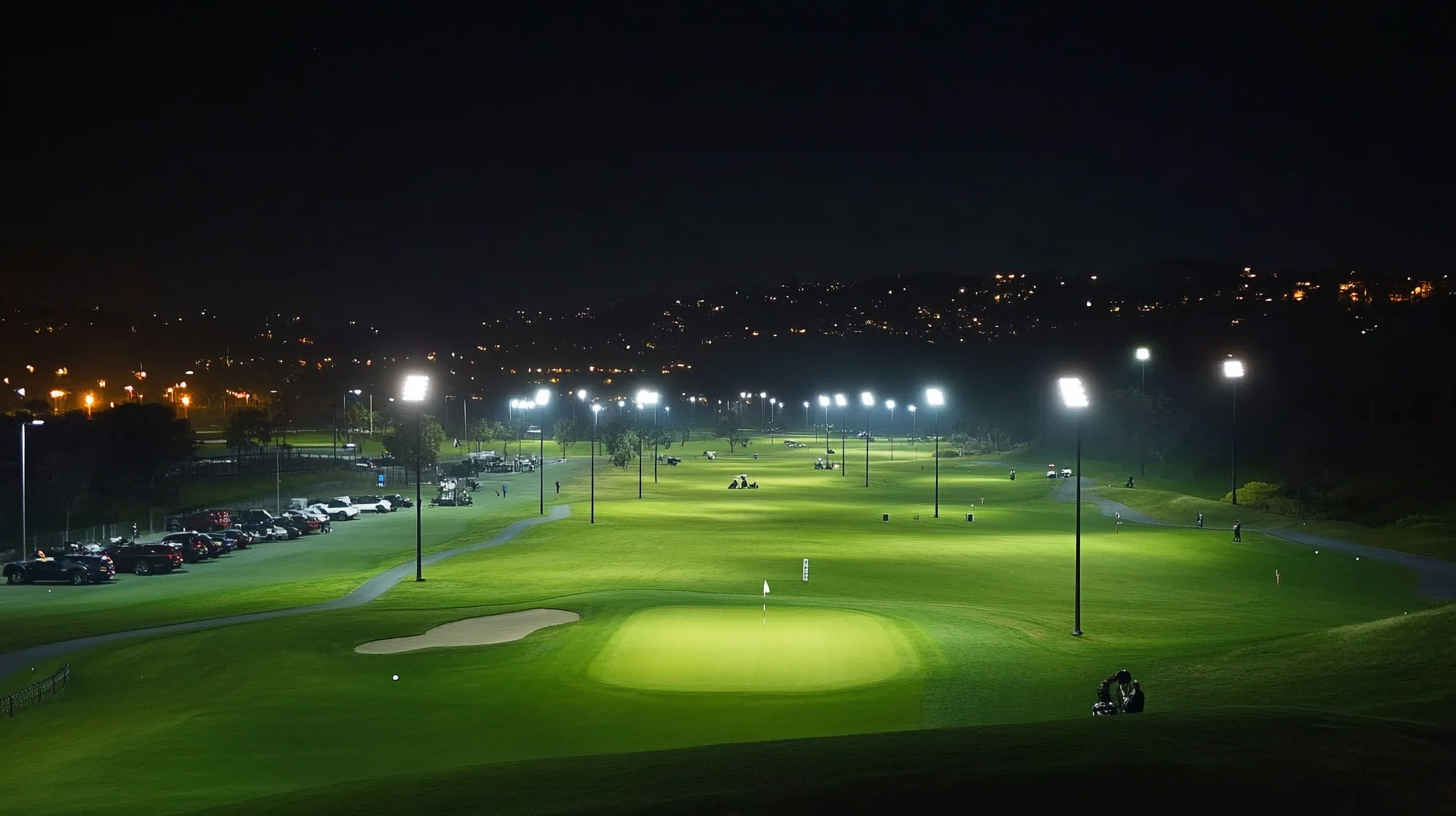
How does lighting design differ for competition venues versus recreational golf courses
If you have a competition golf venue, your lighting needs are way different from a recreational course. You need lights for precision, lights for people to see, and lights to show off to the audience. Here’s what you need:
1. Illumination Standards
- Competition Venues: Require high levels of illumination to meet broadcasting requirements and ensure players and spectators have clear visibility of the course. Lux levels typically range from 700–1,000 lux on greens and tees, and 500–700 lux on fairways.
- Recreational Courses: Use lower lighting levels, generally between 50–300 lux, as they are designed for casual play and local events rather than professional tournaments.
2. Uniformity of Light
- Competition Venues: High uniformity (Uniformity Ratio ≥ 0.7) is essential to avoid shadows and uneven brightness that could affect player performance and video recording quality.
- Recreational Courses: Moderate uniformity is acceptable, prioritizing playability over perfection.
3. Glare and Light Spillage
- Competition Venues: Glare must be minimized to prevent distracting players, officials, and spectators. Advanced optics and shielded LED fixtures are often used.
- Recreational Courses: Less emphasis is placed on glare control and light spillage since lighting serves local players rather than professional athletes or large audiences.
4. Fixture Placement and Design
- Competition Venues: Fixtures are strategically placed on high masts and in critical areas like greens, tees, and fairways to avoid shadows while providing consistent coverage. Advanced designs often include tilt, rotation, and beam-shaping capabilities.
- Recreational Courses: Lighting is installed for convenience and functionality, with simpler setups that may not optimize every angle of the course.
5. Broadcasting and Spectator Requirements
- Competition Venues: Require specialized lighting for high-definition broadcasting, including enhanced color rendering (CRI ≥ 80) and flicker-free operation for slow-motion replays. Additional lighting may be needed for spectator stands and pathways.
- Recreational Courses: Designed purely for gameplay, with no need for broadcasting-quality lighting or dedicated spectator accommodations.
6. Cost and Energy Efficiency
- Competition Venues: Lighting systems are typically more sophisticated, requiring a higher initial investment and ongoing operational costs. They often incorporate advanced control systems for real-time adjustments.
- Recreational Courses: Focus on cost-effective and energy-efficient solutions with minimal automation or customization.
| Aspect | Competition Venues | Recreational Courses |
| Illumination Standards | Require high levels of illumination for broadcasting and visibility: 700–1,000 lux on greens and tees, 500–700 lux on fairways. | Lower lighting levels (50–300 lux) sufficient for casual play. |
| Uniformity of Light | High uniformity (Uniformity Ratio ≥ 0.7) to avoid shadows and ensure even brightness. | Moderate uniformity acceptable; less focus on perfect uniformity. |
| Glare and Light Spillage | Minimal glare using advanced optics and shielded LED fixtures to avoid distraction. | Less emphasis on controlling glare and light spillage. |
| Fixture Placement and Design | Strategic placement on high masts with tilt, rotation, and beam-shaping capabilities to avoid shadows and provide consistent coverage. | Simpler lighting setups focusing on functionality; less emphasis on optimizing every angle. |
| Broadcasting and Spectator Requirements | Specialized lighting for HD broadcasting, high color rendering (CRI ≥ 80), and flicker-free operation for slow-motion replays. Additional lighting for spectator areas. | Designed for gameplay with no need for broadcasting-quality lighting or spectator accommodations. |
| Cost and Energy Efficiency | More sophisticated systems with higher initial costs and ongoing operational expenses, often including advanced control systems. | Focus on cost-effective and energy-efficient solutions with minimal automation or customization. |
By customizing your lighting for your golf course, you can make it do what you want it to do. Whether you have a competition golf venue or a recreational course, you can get what you need. Advanced LED technology makes it possible for you to get what you need, be energy efficient, and last a long time in both cases.
What are the benefits of optimized golf course lighting for golfers
If you have good lighting on your golf course, here are the big benefits:
1. Improved Visibility and Gameplay
Clear Ball Tracking: High-quality lighting allows golfers to track their ball from the tee to the fairway, even over long distances.
Enhanced Course Features: Proper lighting highlights contours, hazards, and slopes, helping players assess shots more accurately.
Reduced Shadows: Uniform lighting minimizes shadows, ensuring better visibility of the terrain, particularly on greens and bunkers.
2. Extended Play Hours
Nighttime Accessibility: Optimized lighting enables courses to remain open after sunset, providing more flexibility for golfers with daytime commitments.
Increased Practice Time: Driving ranges and putting greens can be utilized in the evenings, allowing players to refine their skills at their convenience.
3. Enhanced Safety and Comfort
Safer Navigation: Well-lit pathways, parking areas, and course sections reduce the risk of accidents and improve overall safety for golfers and staff.
Glare-Free Design: Advanced lighting systems prevent glare, making it comfortable for players to focus on their game without strain.
4. Elevated Playing Experience
Aesthetic Appeal: Thoughtful lighting design creates a visually striking environment, enhancing the ambiance of the course during evening play.
Reduced Fatigue: Balanced light levels reduce eye strain, allowing players to enjoy their game longer without discomfort.
5. Support for Competitive Play
Professional Standards: Competition-level lighting ensures accurate gameplay conditions and adherence to international standards, benefiting both professional and amateur golfers.
Audience Engagement: For tournament settings, optimized lighting also enhances the experience for spectators, whether on-site or via broadcasts.
6. Encouragement of Social Interaction
Nighttime Events: Courses with excellent lighting can host events, leagues, or casual games in the evenings, fostering social connections among golfers.
Welcoming Atmosphere: Lit clubhouses and outdoor areas encourage golfers to stay after their rounds for relaxation and camaraderie.
With good lights on your golf course, you can turn it into a place where people can play golf no matter how good they are. They’ll be safe, comfortable, and have a great experience. The best lights for you to use are LED lights. They don’t use much electricity, and you can make them do anything you want.
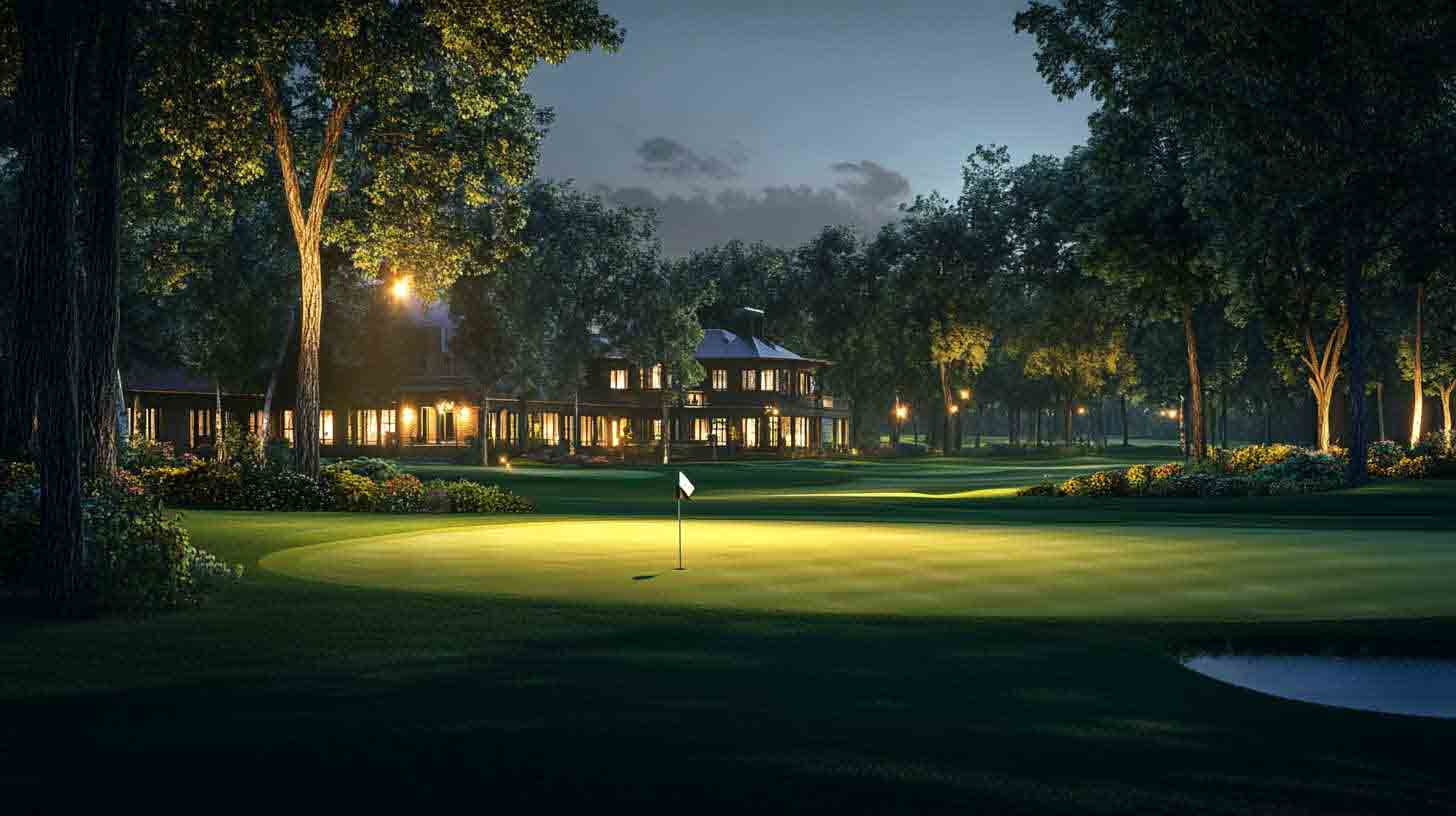
How do you ensure uniformity in golf course lighting
If you’re going to have great golf course lighting, you need it to be the same. You don’t want to have dark spots and bright spots. You want everything to be the same. Here’s how you can do that:
1. Conducting a Comprehensive Lighting Plan
Site Analysis: Evaluate the golf course layout, including terrain, vegetation, and key playing areas (fairways, greens, tees, bunkers).
Lighting Simulation: Use advanced lighting design software to model the course and simulate light distribution, ensuring even coverage and identifying potential dark spots.
Customized Placement: Design the placement and height of light fixtures based on the unique characteristics of each area, such as greens requiring higher lux levels than fairways.
2. Choosing the Right Fixtures and Beam Angles
LED Technology: Opt for LED lights, which provide superior control over beam angles, light intensity, and distribution.
Beam Customization: Select fixtures with adjustable beam angles to suit the area’s size and purpose. Wide beams are ideal for fairways, while narrower beams target greens and tees effectively.
3. Optimal Mounting Heights and Angles
High Mast Placement: Install lights on tall masts to reduce shadowing and provide broader coverage for larger areas like fairways and driving ranges.
Tilt and Orientation: Adjust fixtures to overlap light beams slightly, ensuring seamless transitions without over-illumination or dark patches.
4. Uniformity Ratios and Standards
Adherence to Guidelines: Follow industry standards for uniformity ratios, typically ≥ 0.6 for recreational courses and ≥ 0.7 for professional venues.
Light Meter Testing: Conduct on-site lux level measurements to verify uniformity and adjust placements as needed.
5. Minimizing Glare and Light Spillage
Anti-Glare Features: Use fixtures with anti-glare optics to avoid uneven brightness and enhance comfort for players.
Directional Lighting: Focus beams downward or at specific angles to prevent light from spilling into non-play areas, ensuring concentrated illumination where it’s needed.
6. Maintenance and Upgrades
Regular Checks: Perform routine maintenance to clean fixtures, replace damaged parts, and ensure consistent performance.
Technological Upgrades: Invest in smart lighting controls to dynamically adjust brightness and distribution for real-time needs, maintaining uniformity even as conditions change.
By combining advanced planning, high-quality fixtures, and ongoing maintenance, uniform lighting across a golf course can be achieved, enhancing both the player experience and the course’s aesthetic appeal.
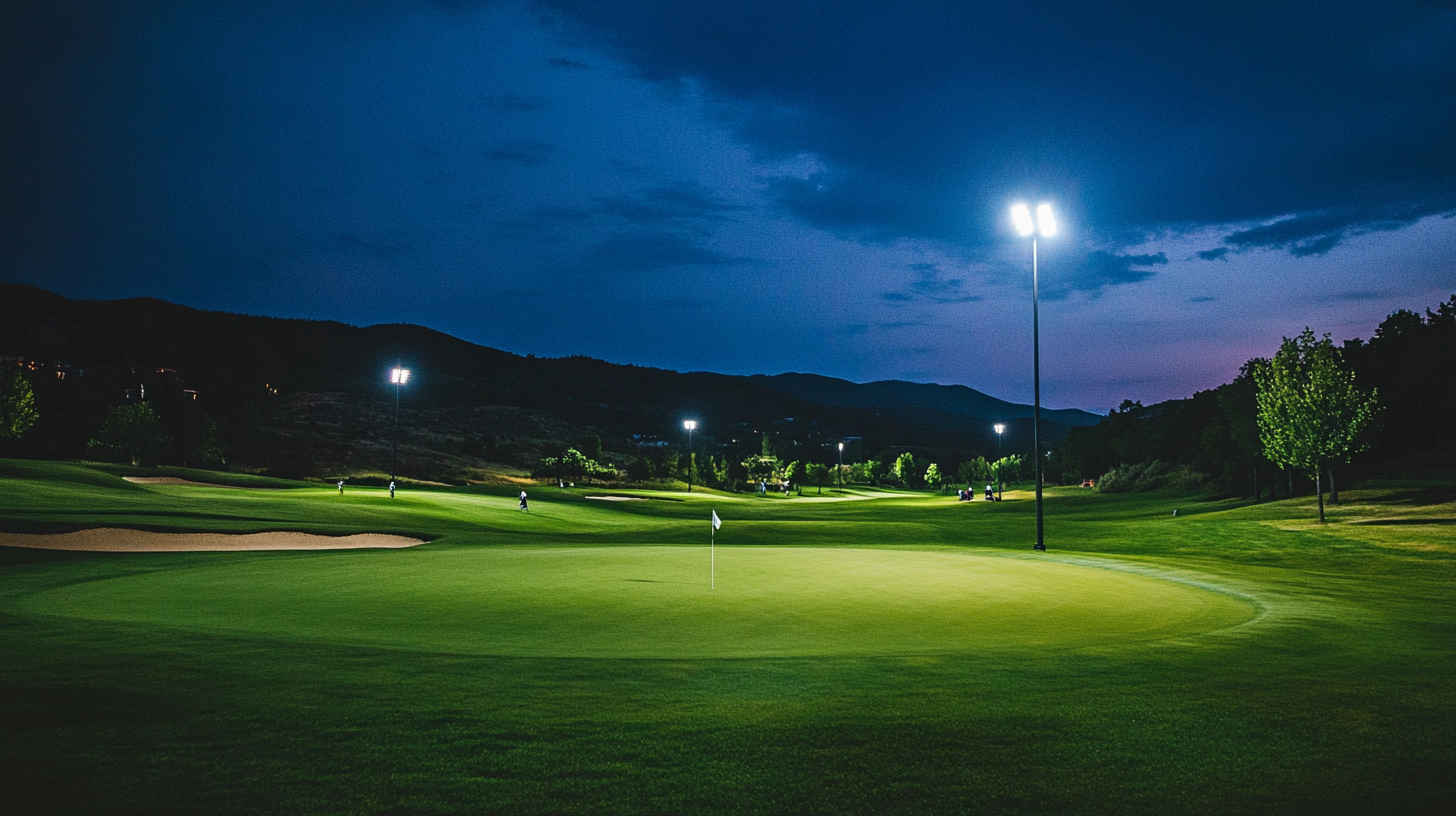
What is the role of color temperature in golf course lighting
The color temperature of your lights is the next thing to think about. The color temperature of your lights affects how well people can see, the look of your place, and how people feel when they’re there. Color temperature is measured in Kelvin (K). The color temperature of your lights can be warm (kind of yellow) or cool (kind of blue). Here’s how it affects your golf course lights:
1. Enhancing Visibility
Neutral and Cool White Light: For most of your golf course, you want lights with a color temperature between 4000K and 5700K. This range of light lets you see everything. You can see the slopes, the hazards, and the balls.
Accurate Color Rendering: Color rendering is how good the light makes the grass, the sand, and everything else look. The better the color rendering, the better everything looks.
2. Creating a Natural Feel
Daylight Simulation: If you want to make your golf course look like it’s not lit up at night, use a color temperature closer to daylight (5000K–5700K).
Reduced Eye Strain: If you have good lights with the right color temperature, you won’t get tired as quickly, and you’ll be able to play longer.
3. Differentiating Functional Areas
Fairways and Greens: Require cool white light (4500K–5700K) for clear visibility and even illumination of expansive areas.
Pathways and Parking Lots: Warm white light (3000K–4000K) creates a softer, more welcoming ambiance for non-playing zones, enhancing safety without causing glare.
Clubhouses and Outdoor Seating: Warm tones (2700K–3000K) contribute to a cozy, relaxed atmosphere suitable for social interactions.
4. Supporting Professional Requirements
Broadcasting Standards: Professional golf tournaments demand higher-quality lighting with cooler temperatures (5000K–5700K) to ensure clear visibility for players, spectators, and high-definition broadcasting.
Uniform Appearance: Consistent color temperature across the course ensures a professional look and avoids mismatched lighting that can distract players and viewers.
5. Highlighting Aesthetic Appeal
Contrast and Depth: Cooler temperatures enhance the vibrant green of the turf and the contrast between different course elements, such as water hazards and sand traps.
Scenic Beauty: Strategic use of varied color temperatures can create dramatic effects, enhancing the golf course’s visual appeal during nighttime events.
If you’re careful about the color temperature of your lights, you can make your golf course look great. Your golfers and the people who come to your place will have a great experience. You can do all of this with advanced LED lighting systems that have adjustable color temperatures. Learn more about LED Light Color Temperature: Which is Best for Sports Field Lighting?
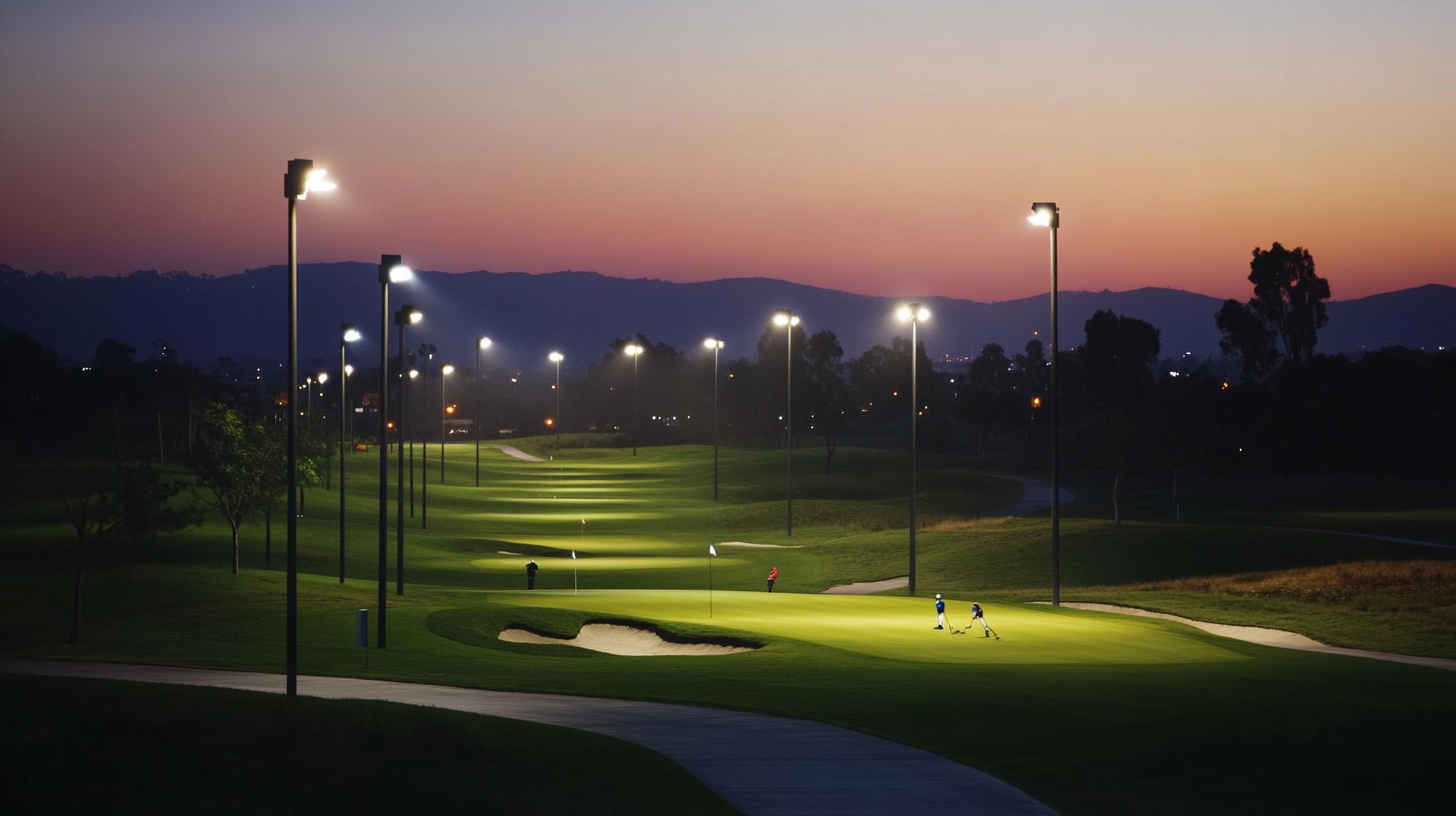
How do you minimize glare in golf course lighting
One of the things you want to be careful about with your golf course lights is glare. If you have too much glare, it will mess up your golfers, their eyes will hurt, and they won’t have a good time. Here’s how you can make sure you don’t have too much glare:
1. Use Anti-Glare Optics
Specialized Lenses: Install LED fixtures with anti-glare optics or diffused lenses that soften the light and reduce direct glare.
Shielded Fixtures: Use fixtures with hoods or shields to block excessive light from escaping at unwanted angles.
2. Proper Placement and Angling
High Mast Lighting: Mount fixtures on tall masts to distribute light from above, minimizing the chance of direct light reaching players’ eyes.
Adjust Beam Angles: Direct light beams downward or toward specific areas like fairways and greens, avoiding horizontal or upward angles that cause glare.
Avoid Line of Sight: Position fixtures so that they are not directly in the sightlines of players, especially when teeing off or putting.
3. Choose Narrow Beam Angles
Focused Lighting: Use fixtures with narrow beam angles for precise illumination of targeted areas, such as greens or tee boxes, without scattering excess light.
Layered Approach: Combine narrow and wide beams strategically to balance coverage and reduce intensity at eye level.
4. Implement Uniform Lighting
Even Distribution: Ensure that light levels are consistent across the course to avoid sudden bright spots, which can create glare and visual discomfort.
Overlap Light Beams: Overlap beams slightly to eliminate dark patches without causing over-illumination.
5. Opt for Lower Color Temperatures in Some Areas
Moderate Brightness: Use warmer color temperatures (3000K–4000K) in non-play areas like pathways and parking lots to reduce harsh brightness.
Balanced Light: In playing zones, choose cooler temperatures (4000K–5700K) but manage intensity to avoid overly harsh lighting.
6. Use Advanced Lighting Controls
Dimming Capabilities: Install systems with adjustable brightness levels to lower light intensity when full power isn’t needed.
Directional Adjustments: Use smart controls to fine-tune fixture angles and reduce glare dynamically based on player movement or event needs.
7. Conduct On-Site Testing
Simulate Gameplay: Test lighting setups under real gameplay conditions to identify glare issues and adjust fixtures accordingly.
Player Feedback: Gather input from golfers to ensure the lighting is comfortable and functional from their perspective.
8. Maintain Fixtures Regularly
Clean Surfaces: Dirt and debris on lenses can scatter light unevenly, increasing glare. Regular cleaning ensures optimal performance.
Replace Worn Parts: Over time, lenses and coatings may degrade, leading to increased glare. Timely replacements help maintain quality.
If you’re careful about how you do things, you can make sure you don’t have too much glare. If you don’t have too much glare, people will be safe and have a great experience. The best lights to use are LEDs with good optics and controls. Read more about All You Need to Know About Anti-Glare Lighting and Reducing Glare
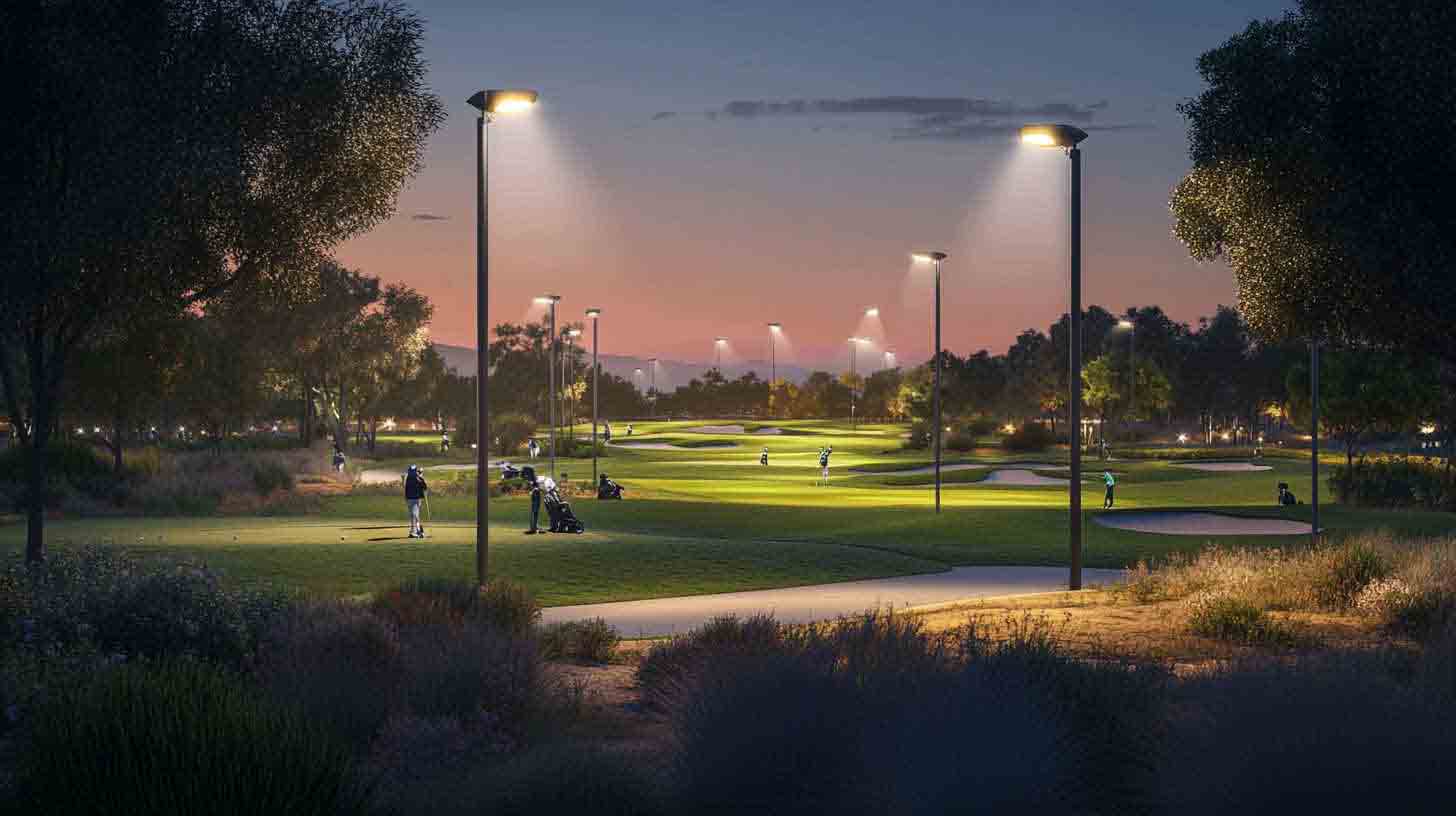
How should light poles be positioned on a golf course
Where you put your light poles is a big deal. If you put them in the right place, you’ll have great light and your golfers will play well. Here’s a quick guide:
High Mast Placement: Use tall poles (20–30 meters) to distribute light evenly over large areas like fairways and greens.
Tee Boxes and Greens: Position poles slightly behind or to the sides to avoid glare and shadows affecting players’ visibility.
Fairways: Space poles along the edges, angled inward to overlap beams and ensure uniform coverage.
Avoid Direct Sightlines: Ensure lights are out of players’ direct line of sight to prevent distractions.
Driving Ranges: Place poles at the back and sides with narrow beam angles for targeted lighting.
Pathways and Parking Areas: Use shorter poles (6–10 meters) with diffused lights for safe, glare-free illumination.
If you put your light poles in the right place, you’ll have great lights, and your golfers will play well.
How does lighting impact golfers’ performance
Your lights make a huge difference in how well you play golf. Here’s how:
Improved Visibility: Bright, uniform lighting helps golfers track the ball, see course contours, and assess terrain features like slopes and hazards.
Reduced Glare: Properly designed lighting minimizes glare, enabling clear vision without distractions or eye strain.
Accurate Depth Perception: Balanced lighting enhances the perception of distance, crucial for precise shots.
Extended Playtime: High-quality lighting allows for evening play, providing flexibility and more practice opportunities.
Mental Focus: Comfortable, well-lit environments help players maintain concentration, improving performance.
If you have good lights, you’ll have a good time playing golf.
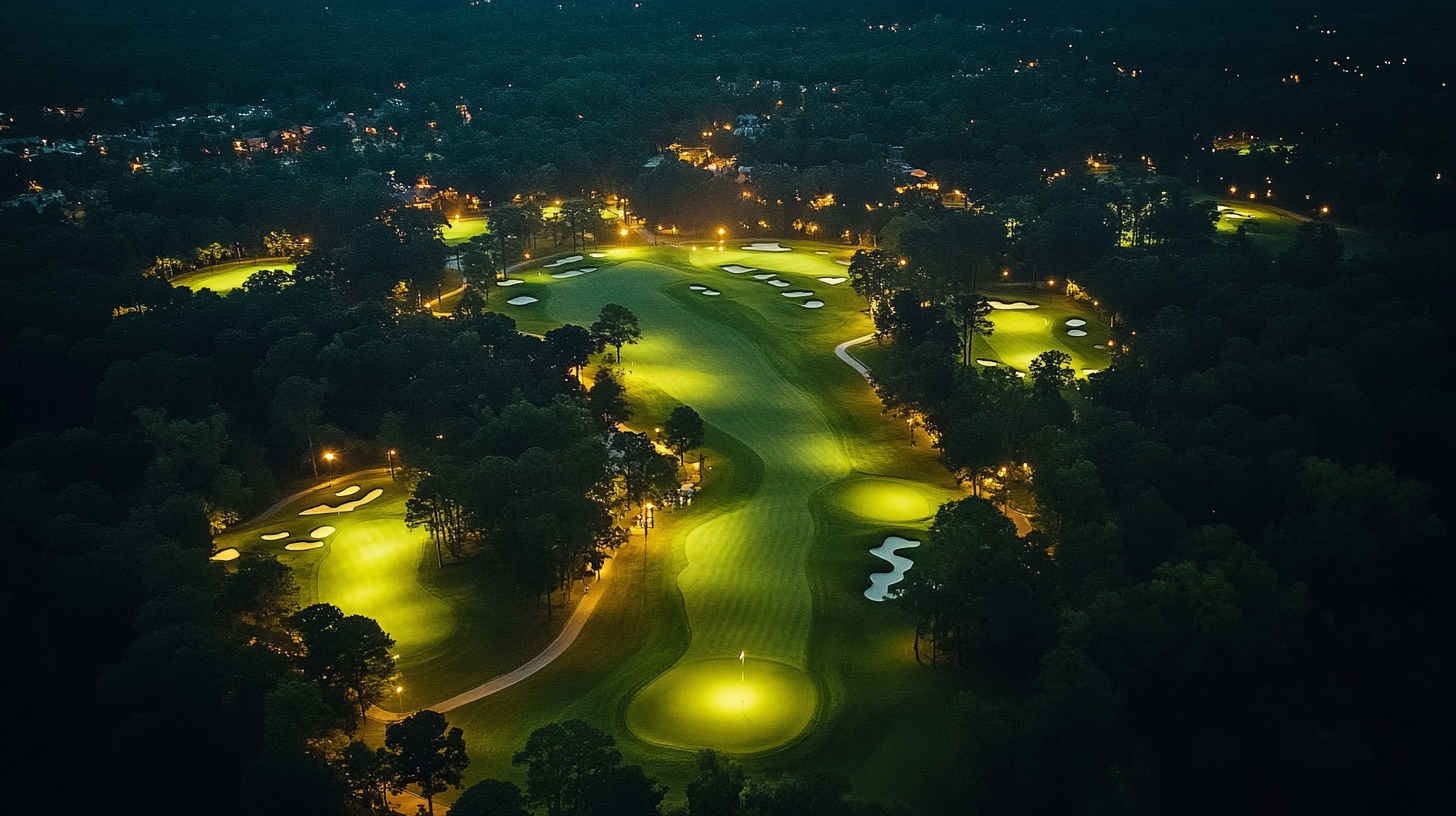
FAQs about Sports Field Lighting
What are the Requirements for Sports Field Lighting?
If you have a sports field like a golf course, you need to worry about three things with your lights: making sure the light is the same all over the place, making sure you’ve got enough light so people can see, and making sure you don’t have too much light or it’s pointed in the wrong place.
What to Do if There is Lightning on a Golf Course?
When you have lightning in the area, you need to have a plan. You need to be watching the weather. You need to have a warning system to get people off the golf course. You need to have places for people to go to get out of the way of the lightning.
How Much Would it Cost to Put Lights on a Golf Course?
Putting lights on your golf course can cost you a lot of money. It just depends on how big your golf course is and what kind of lights you use. A rough guess is you’ll spend a few thousand dollars all the way up to several hundred thousand dollars to put lights on your golf course. The good news is that LEDs, although they cost more upfront, will save you money in the long run because they don’t use as much electricity and don’t break down as often.
What is the Price to Install Outdoor Lights?
The cost of putting lights outside depends on what type of lights you buy and how many you need. For a house, you might spend $2,000 to $5,000. For a commercial property like a golf course, it can be a lot more. The type of lights you buy and who you have put them in will determine how much you spend.
Why Do Golf Courses Charge So Much?
Golf courses charge high fees to cover various operational costs, including maintenance, staffing, landscaping, and amenities. Lighting is a significant part of these costs, especially if the course uses high-end systems to ensure optimal playability and safety during evening hours.
Why is Outdoor Lighting So Expensive?
Lights outside cost a lot of money because they have to be able to withstand the weather. The lights need to be made of good stuff and have good technology in them. High-quality systems like LED lights for golf driving ranges are costly due to their long lifespan, lower energy usage, and superior illumination capabilities.
How Much Do Permanent Outdoor LED Lights Cost?
LED lights outside are expensive. How much you pay for them depends on what you buy, where you buy it, and who puts it in. The good news is they last a long time, use very little electricity, and make good light. A rough guess is you’ll spend a few hundred to a few thousand dollars per light.
How Much Does Labor Cost to Install Can Lights?
Labor costs for installing can lights can range widely, typically between $50 to $100 per hour per technician. Factors that affect the cost include the project’s complexity, the location, and the type of fixtures being installed. In a golf course setting, specialized lighting might require expert installers, increasing the labor costs.
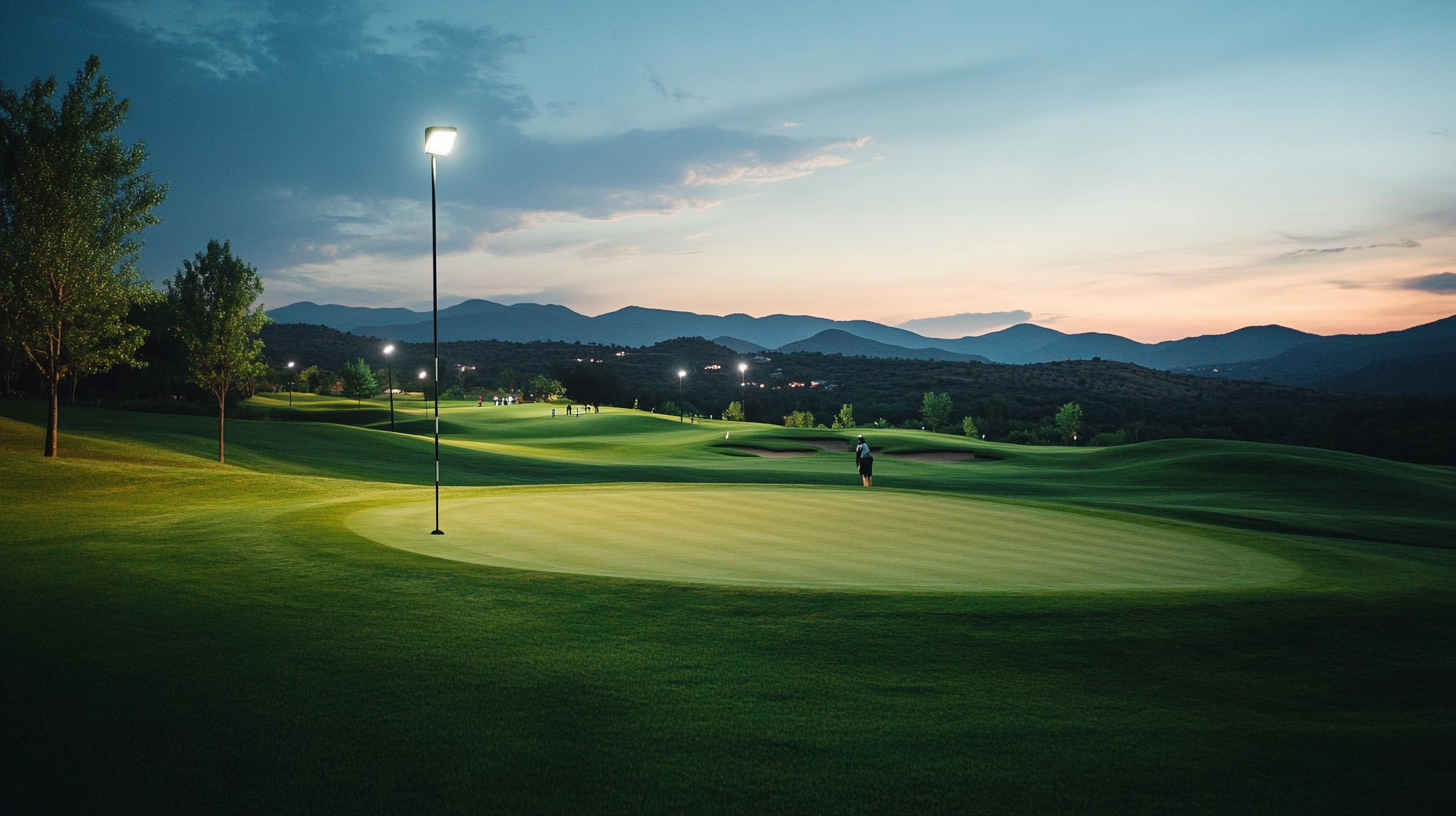
What Types of Lighting Fixtures are Best for Tee Areas?
Tee areas benefit big time from directional and focused lighting fixtures like floodlights. Floodlights give you clear, focused light without blinding the players or the people watching them. LED fixtures are becoming very popular because they’re efficient and give off bright, uniform light that looks like natural daylight.
What are the Challenges of Lighting Hilly Fairways?
Lighting hilly fairways is tricky because you have to make sure the light is even across the ups and downs and there aren’t shadows that will keep people from being able to see. You have to know where to put the lights and use fixtures that throw light in a wide pattern. The newer adjustable LED systems can help you overcome some of these issues.
Conclusion
In conclusion, good golf course lighting is important for safety, playing, and how things look. If you understand what you need and what you’re up against, you can put in the right stuff to make everybody happy and hit your goals. Whether you’re upgrading to LED lights or putting in new fixtures, make a plan and spend the money to do it right. You will be happier, your players will be happier, and you will save money on maintenance.
If you have any questions about golf course lighting, just feel free to contact us directly. Our lighting experts are ready to help.
Request A Free Quote Now!
Send us a message if you have any questions or request a quote. We will get back to you ASAP!



